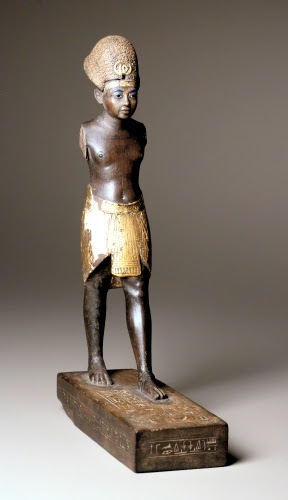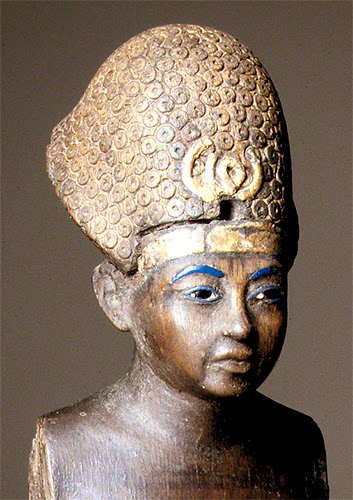My Amenhotep III Excitement
The typical art history dork in me skipped through an imaginary daisy field last week when I read this article about the display of artifacts from the tomb of Amenhotep III (died ca. 1354 bce) in Thebes. He was supposedly one of the greatest pharaohs, while Dynasty XVIII is considered the high point of Ancient Egyptian culture. It may just be because at that time the Egyptian “empire” had extended from conquests in Iraq to the Sudan. I just LOVE it that archeologists are still unearthing Egyptian sculpture!
 |
| Egypt, Amenhotep III, ca. 1382–1344 BCE. Gilt wood, height: 10 3/8" (26.3 cm). © Brooklyn Museum. (BMA-568) |
Amenhotep III became pharaoh at the age of 12 when the Egyptian empire was at its greatest extent. He managed to maintain stability largely through diplomacy and strategic intermarriage with Syrian (Mitanni), Anatolian, and Babylonian royal houses. Although he emphasized diplomacy, he is often depicted, as in this small sculpture, in the blue (war) crown to emphasize his power.
 |
| Egypt, Amenhotep III, detail, ca. 1382–1344 BCE. Gilt wood, height: 10 3/8" (26.3 cm). © Brooklyn Museum. (BMA-568) |
In keeping with the tradition of Egyptian royal portraiture, Amenhotep is depicted striding forward confidently. Amenhotep III was the father of Akhenaten and Tutankhamun (brothers from different wives). The relaxed idealism of this piece is a harbinger of the revolutionary style under Akhenaten, which dispensed with the rigid formality and stiff idealization of royal subjects.
Amenhotep III was a great builder. He extended courts in the royal temples at both Karnak and Luxor, dedicated to Amun. He also built temples up and down the Nile in a nationwide building program to enhance his authority. He also encouraged the worship of the sun god Ra, the solar disc “Aten,” as a way of foiling the power of the Thebean priests of Amun, a local god of Thebes, who during the 18th dynasty obtained the status of creator-deity, except during the period of the reign of Akhenaten, who considered Ra supreme.
Correlations to Davis programs: A Global Pursuit 1.4; Discovering Art History 5.3; The Visual Experience 10.2, 15.3; Beginning Sculpture 5


Comments